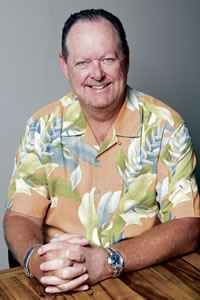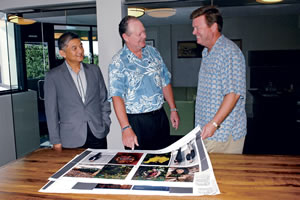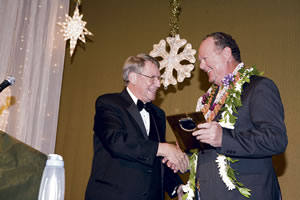The 2 Million Dollar Man

Dennis Francis
Dennis Francis, president and publisher of the Star-Advertiser and MidWeek, created a program that has raised $2 million for Ronald McDonald House and become a national model. RMH says thank you with a dinner in his honor Sunday
Dennis Francis wasn’t allowed to have a paper route as a youth because his mother didn’t think he was responsible enough. He was too easily distracted by his passion for sports.
Forty years later, Francis not only controls most of the newspaper subscriptions in the state, but also guides the destiny of Hawaii’s largest newsgathering organization. Obviously his sense of responsibility improved with age. As for spending time with his buddies and enjoying sports, especially now with golf well, that hasn’t changed much.
Francis’s sense of responsibility, particularly his strategic business sense aligned with community advocacy, will be recognized at the annual “Share-a-Night Gala” on Sunday at Sheraton Waikiki, presented by Ronald McDonald House Charities of Hawaii.
Francis, president of Oahu Publications Inc. (OPI), MidWeek‘s parent company, and publisher of the Honolulu StarAdvertiser, has been a hero and supporter of Ronald McDonald House for more than 20 years. He created an innovative and groundbreaking program that put newspapers in every single McDonald’s restaurant, with a portion of sales revenues donated to Ronald McDonald House Charities. The concept was adopted nationally after a successful launch in the Islands. The partnership has generated $2 million to date in Hawaii.

MidWeek publisher Ron Nagasawa, Dennis Francis and OPI senior VP of marketing Dave Kennedy discuss final plans for a magazine layout Nathalie Walker photo | nwalker@midweek.com
“Pretty amazing,” says RMHC executive director Jerri Chong, who noted that donations continued without interruption even while the local papers were going through organizational changes and ownership transitions. “Dennis’s word is his bond,” she says.
When a charity helps 500 families a year, that means a lot. Particularly in times when government and private funding are dwindling. To date, 10,000 families and more than 25,000 people have called Ronald McDonald House home, some for just a few days, others for months, according to Chong. The financial resources from newspaper sales at McDonald’s restaurants have sustained a critical community service, she adds.
We’re loving it. Makes those McCafe brews and McMuffins even more tasty.
But it’s not the meal deal that brings the Honolulu Star-Advertiser and its driven publisher into the spotlight.
No, it’s the real deal.
But getting Francis to talk about himself and the back-story of his role in merging two daily newspapers is not easy.
“I’ve shied away from interviews,” Francis says, “because I never felt comfortable with what might appear to be self-serving.”
False modesty? That’s not Francis’ style, co-workers will tell you. This is a seriousminded executive who is a man of few words, even in that world of word merchants in which he dwells. So it is with some apprehension that we meet with Francis in his Restaurant Row fifth floor office. But we find him relaxed and chatty, perhaps because he just returned from a vacation in his hometown states, Kentucky where he was born and Ohio where he was raised. (Yes, he is a big Ohio State Buckeyes and Kentucky basketball fan.)

Publisher Dennis Francis holds the first Honolulu Star-Advertiser to come off the press at the Kapolei printing plant, June 6, 2010 Honolulu Star-Advertiser photo by FL Morris
It was well-deserved down time, we thought, for someone who recently wrote one of the toughest chapters in Hawaii’s long newspaper history. It is Francis who administered the strategic plan resulting in OPI’s purchase of the Honolulu Advertiser in June 2010.
It was a game-changing, landmark deal that created a print media juggernaut. The OPI group includes the Star-Advertiser, separate MidWeeks on Oahu and Kauai (including four regional MidWeek Islanders on Oahu), HI Luxury magazine (part of a glossy magazine division that includes a quarterly Kailua magazine and another for the UH booster club Ahahui Koa Anuenue, and in-room magazines for several large hotels), a tourist magazine 101 Things To Do and three military newspapers. OPI also manages Internet sites and does commercial printing and direct mail. It employs 476 people.
A year and a half into the new StarAdvertiser venture, we ask how things are going.
“The paper is doing great,” Francis answers. “Our revenues are about what we had expected, print circulation is growing, and our new digital media approach with StarAdvertiser.com is one of the most successful premium content sites in the country for a market our size.”
If fate had dealt Francis different cards several years ago, he would be managing Gannett newspapers in New Jersey. Instead, the 53-year-old executive is living and working in paradise with a colorful career that track with the modern-day history of Oahu’s major newspapers.
“I’m probably the one-and-only aligned with the history of Honolulu dailies,” he reflects. “I was on both sides. I moved to Hawaii in 1989 as an employee of Gannett to serve as vice president-circulation for the Hawaii Newspaper Agency at the age of 31.
“In May of 1998 I was named general manager of HNA and later for the Honolulu Advertiser when the two dailies split and operated under separate owners outside of the JOA (joint operating agreement). In June 2004 I joined Oahu Publications as president and publisher for Star-Bulletin and MidWeek newspapers,” he says.

Dennis Francis, pub- lisher of the Honolulu Star-Advertiser, is awarded the Service to Hawaii's Youth Award by Sid Rosen at the Nov. 26, 2010, Adult Friends for Youth Fundraiser. Leah Friel photo lfriel@midweek.com
He then gives a capsulated version of the saga of two dailies, as only Francis can tell it. He knows chapter and verse of the media-go-round that marks Hawaii’s journalistic drama, which sounds more like a who’s-on-first romp.
“The Honolulu Advertiser was founded in 1856. Gannett purchased the paper in 1993. Gannett was controlling partner of the JOA. We controlled the business operation of both newspapers.
“In 1993, Gannett sold the StarBulletin and bought the Advertiser but it still controlled the JOA. In 2000, when the JOA split, David Black purchased the Star-Bulletin.
I was then general manager of the Advertiser. Four years later, I left Gannett to head the Star-Bulletin and Oahu Publications.
“Interestingly, I was in the planning meetings on the Gannett side of the JOA split. I was actively selling against the Star-Bulletin during the split. Years later, I become president-publisher and said, ‘Well, on the other hand …’” he recalls with amusement.
But his intimate knowledge of the paper’s history, its structure and its future potential gave him an advantage as a visionary leader. Call it Dennis’ due diligence:
“I hear a lot across the country about the so-called handwriting on the wall and the demise of newspapers because of the new information age, particularly the Internet, but I always looked at the Internet as just another segment of our media footprint. I never looked at it as a move away from print to electronic media. Not everyone goes to the Internet for information. It’s a perception more than a reality at this point and time.
“The reality is that the Star-Advertiser with its 140,000 paid circulation reaches almost half of the households on Oahu. Partnered with MidWeek that is delivered to every home on Oahu and Kaua’i, it’s a powerful reach. On Oahu, total combined weekly readership is 536,104. No other media comes close to it.
“The Internet is just another way people get information. It’s not competition. It’s a vehicle to deliver content and provides another option to read our newspaper. I’m more concerned about the competition for people’s time,” he adds.
The establishment of StarAdvertiser.com, offering premium content on a web page, is considered a model in the industry. Like the groundbreaking newspaper-fast food partnership benefitting charity, it’s a Dennis Francis business model.
Doing business that aligns with a “greater good” is a Francis axiom. That’s the way he professes to serve the community he chose for a preferred lifestyle and career.
He shares that idyllic life with wife Marjorie. As he states in a book entitled Greater Good, “I wouldn’t say giving back is important, I would say it’s a must.”
In addition to involvement with Ronald McDonald House Charities, Francis is affiliated with Diamond Head Theater, Adult Friends for Youth, Friends of Cancer Research, American Red Cross, Chamber of Commerce, Hawaii Business Roundtable and is currently serving on the APEC Host Committee.
“Private business must step up to help nonprofits,” he says emphatically.
While he’s waxing philosophically, we solicit his views of the new information age.
“Newspapers still kick-start a lot of stories,” Francis responds. “Certainly other media have their own take on news and get their share of breaking news, but the story usually begins with us (print medium). What a good newspaper provides is information.
“Sometimes we get so focused on the news content, we don’t appreciate that almost half of the newspaper is advertising. Advertising is information too, including what’s on sale at Longs or at Macy’s, as an example. “Annual surveys tell us some of the most-read parts of the paper are advertising inserts and special sections.”
What about the social networking and blog trends, we ask.
“I think it encourages citizen journalism,” Francis says. “It allows the average person to express opinions openly and freely. It encourages discussion and dialogue. That’s good for our free society.
“It is powerful to be working in an industry that’s a part of the U.S. Constitution,” he says. “We have to remind ourselves of that every day. It’s a serious responsibility. One of those responsibilities, as an example, is to keep government accountable and transparent. Officials shouldn’t look at that with trepidation. They should embrace it because ultimately it gives people information that will help facilitate participation in the democratic process.”
Well, how does one come off a lofty, patriotic conclusion to the interview like that? There is nothing more to do than to leave his office quietly, wish him well as the Honolulu Star-Advertiser receives accolades from a grateful charity, and go out to Longs to buy an American flag.



